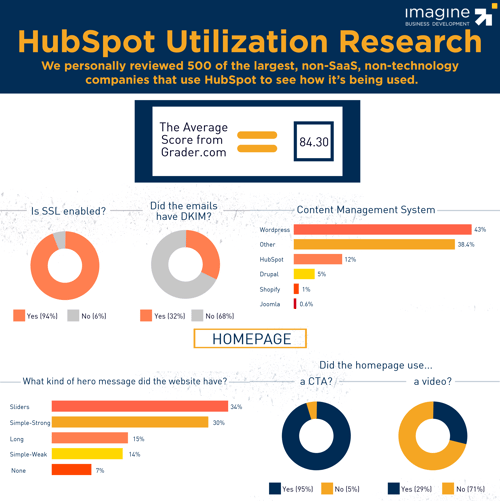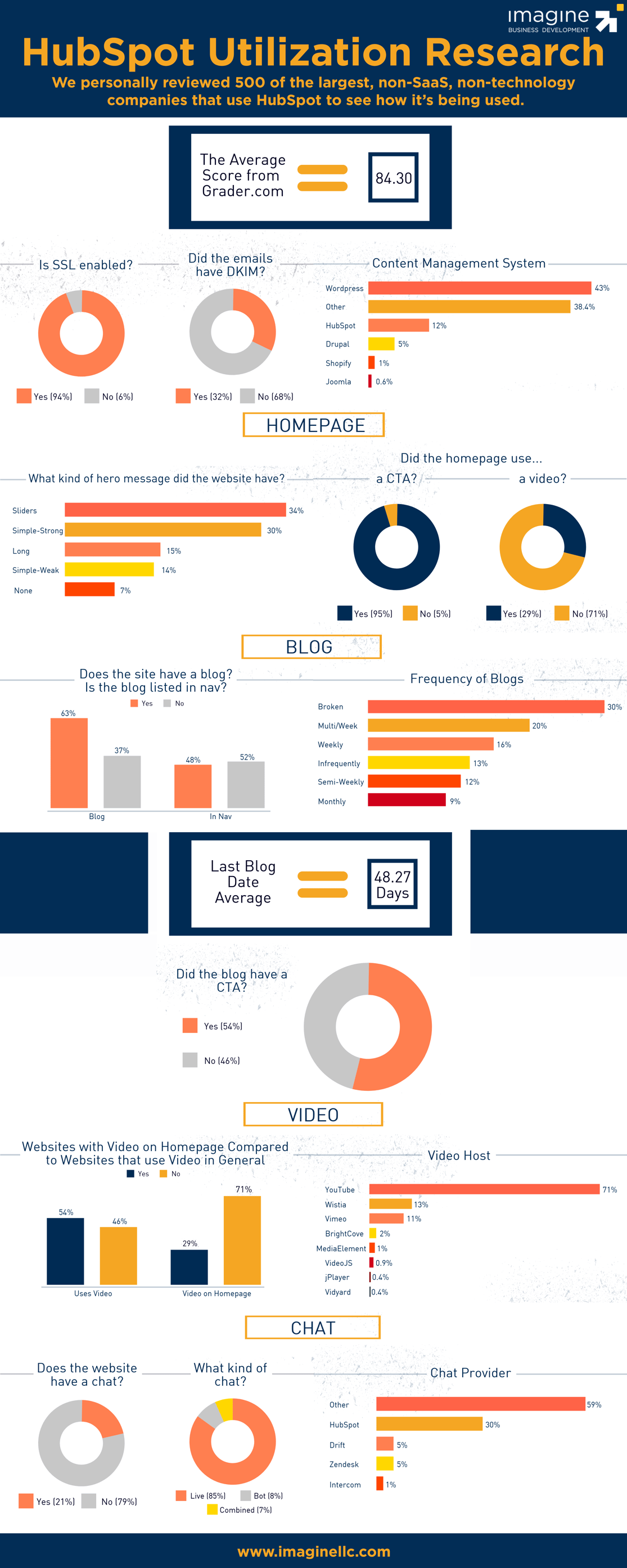HubSpot Utilization Research
 HubSpot Utilization Research Uncovers Important Areas to Focus On
HubSpot Utilization Research Uncovers Important Areas to Focus On
Companies are spending more money than ever before on technology applications (and that doesn’t even account for the “free” software that’s been installed). Our Martech Advisory Services group has had a front-row seat from multiple perspectives:
- Designing, building and maintaining our tech stack
- Advising companies on the design of their tech stack
- Deep implementation with a variety of companies to help them drive greater sales velocity
Over the last three years, we’ve seen an explosion in both the choices and active demand for Martech. Three years ago we had to “push” the tech utilization conversation to our clients. We had to demonstrate the business for considering the use of new technology before we could talk about anything specific. Today, we’re getting “pulled” into the conversation.
On one hand, this is good news (at least for us). Businesses, more than ever, understand the need to optimize and accelerate their processes and they understand that new technology is often required to do so.
On the other hand, we started to see that there was some bad news about this as well. Increasingly, organizations viewed technology as “the” solution to a problem. What’s more, in the tech stack analysis we did, we often saw that companies had bigger stacks than ever and were often not utilizing the existing apps they had appropriately and/or were considering new apps to solve problems that their existing tools could solve if they were using them better.
These observations led to a growing hypothesis we wanted to test. The hypothesis is that while there is growing (exploding) demand for new technology, most companies would be better served by improving how they’re implementing their existing tech stacks and processes before adding new tech.
To test this hypothesis we decided to look at how mid-market companies are utilizing a core part of any growth tech stack - their marketing automation platform. So, over the last two months we conducted a fairly in-depth research project.
The HubSpot Utilization Research
I should add that we also wanted to see how the “real” world was using technology. In preparing to do our research, we dug even deeper into the existing research (both data-driven and anecdotal) around how companies are using Martech. When you look at the bulk of the material in this space, you’ll quickly realize the SaaS (software as a service) companies have a disproportionate presence and skew results.
So we used Datanyze to identify the 500 largest companies that meet these criteria:
- Use HubSpot Marketing
- Revenue greater than $10 million and less than $250 million
- Not in the SaaS or technology industry
You can see the initial results in the infographic at the bottom of this post.
Hypothesis Confirmed: Companies Are Not Adequately Utilizing Their Existing Martech Stack
We’ll be breaking out the research into various cohorts in the near future, but while we were not surprised to see that there’s significant room for improvement, we were somewhat surprised to see that the amount of money spent on the tech was not indicative is how well companies were utilizing their technology. The companies in our analysis spent as little as $10,000/year on their tech stack to more than a half-million.
Here are some of the highlights:
- 68% of users have not enabled DKIM authentication for their marketing emails.
- A little over a third (37%) of the companies we researched do not have a blog.
- Of the near two-thirds (63%) that have a blog, nearly half (48%) make it hard to find as it’s not listed in their primary navigation.
- Of those that are blogging, nearly half (46%) of the blogs to not consistently use CTAs to generate greater engagement or lead generation/conversion.
Broken Blogs
Blogging has proven to be a great tactic for both generating a new audience through SEO and for nurturing and cultivating your existing audience. When you consider how HubSpot started primarily as a blog provider and has been evangelizing blogging for more than a decade, you would think that companies that use HubSpot would be far more likely to be actively blogging. If that’s the case, then the case for blogging may be in trouble.
- 30% of blogs are broken (meaning they have a blog, but there’s been no blog posted in the last 3 months and less than 2 in the last year)
- Only 36% of the companies we reviewed posted blogs on a weekly or more frequent basis
- The average age of the last blog post was 48.27 days
Here’s our take: no question blogging requires a commitment, and that generating results with blogging is harder than ever. That said, it’s still one of the best tactics available if you execute consistently. This data supports our belief that one of the primary reasons that people are complaining about the results of blogging isn’t the lessening impact of the tactic, but the failure to commit to it.
Is Video The Next Big Thing?
We were surprised (somewhat) by the use of video today:
- 54% of websites use at least one video
- Only 29% use video on their homepage
- YouTube is the dominant video hosting platform (even though HubSpot provides free video hosting) with 71% share.
- Wistia is the only advanced video hosting platform with any meaningful share at 13%
As we break down the research over the next couple of months I’ll be able to share more details on this. While more than half of the sites used video, I’d estimate than 2/3rds of those have fewer than 3 videos on their site.
Here’s our take: Video is certainly a big deal, but we think there are still far more people talking about doing video than those who are doing it. That said, video is a TREMENDOUS tactic to generate, leverage and increase acquisition capacity. 2020 should be the year that those who have not gotten serious about video do so.
Where Does Conversational Marketing (Chat) Stand?
As things stand right now, chat, or conversational marketing, is still on a secondary focus (at best):
- Only 21% of sites reviewed are using any form of chat
- Of those using chat 85% are only using live chat with 15% using some form of a bot to support the tactic
- While it’s no surprise that HubSpot’s chat tool is, by far, the leading tool being used, it’s only used by 30% of those using chat. Drift and Zendesk both have a 5% share.
Here’s our take: To paraphrase a Gartner term, conversational marketing and chat are still very much in the hype phase, when there is still far more buzz about the tactic/tool than there is real utilization that supports outcomes. The anecdotal research we did through conversations with several companies that we researched is that most key executives aren’t really even thinking about the role of chat. Online chat certainly provides some (potentially) powerful capabilities, there’s still a lot that needs to be figured out before it becomes a predominant tactic in the demandgen toolkit. By the way, this is a place where if we had included SaaS/tech companies in the list the usage would be very different (though I’m not certain the results would be).
The Homepage & Messaging: Still Much Work to be Done
This is where we saw some good news:
- 94% of the sites reviewed are SSL enabled. Side note: while this is good news, there is some disappointment that HubSpot provides SSL “out of the box” so there are still 6% that aren’t taking advantage of it. In today’s data-security paranoid world we live in, I’m amazed by this.
- 95% of sites are using a clear call-to-action on the home page.
- The average web grader score for the sites viewed was 84.30
The message and structure of most homepages still need a lot of work.
- Only 30% of sites use a simple, strong hero message to strongly position who they are and why they matter, making it easier for the visitor to contextualize the company’s content
- 34% are still using sliders as their hero module
- 29% are using confusing, ambiguous Hero Messages
Here’s our take: It’s far easier to add another tech app than it is to work through the painful exercise of clearly defining your customer acquisition process, the online path & journey and the clear messaging to make it all work. Unfortunately, if you don’t nail down those three areas, the tech “solution” you use isn’t going to solve much. Nail those three things down first, and you’ll quickly see how much easier everything else becomes.
TL;DR
Technology is a powerful enabler and accelerator. It is not, however, in and of itself a solution. Yes, you need to be paying attention to Martech. Yes, you need to have a technology strategy. Yes, there are likely important gaps in your existing tech stack. However, technology has always operated on the principle of garbage in, garbage out. Technology is powerful when you’ve built a strong foundation, and it’s complex and chaotic when you have. Spend a bit more time on the fundamentals, and you’ll likely find you won’t have to spend as much time, and energy, on everything else.



